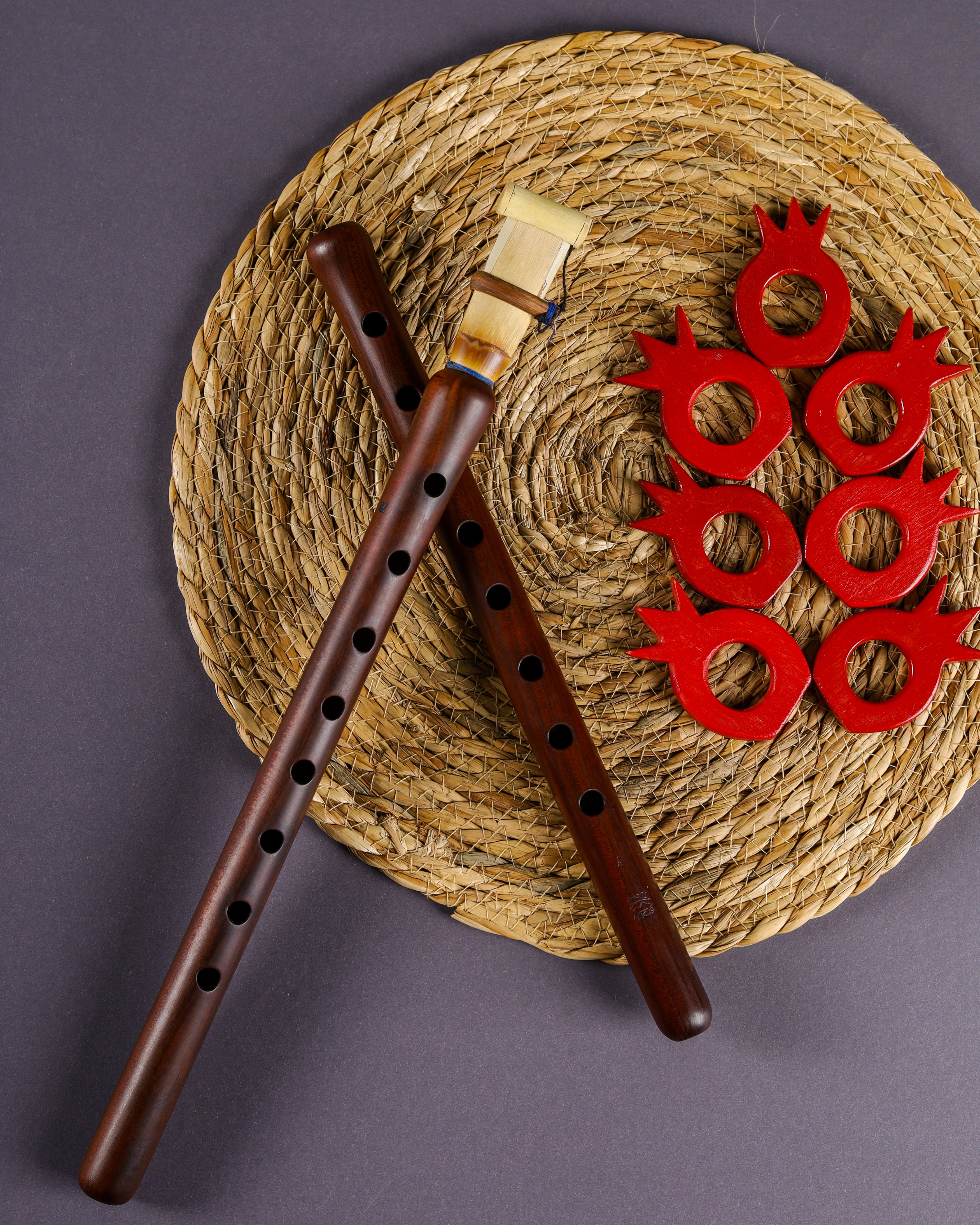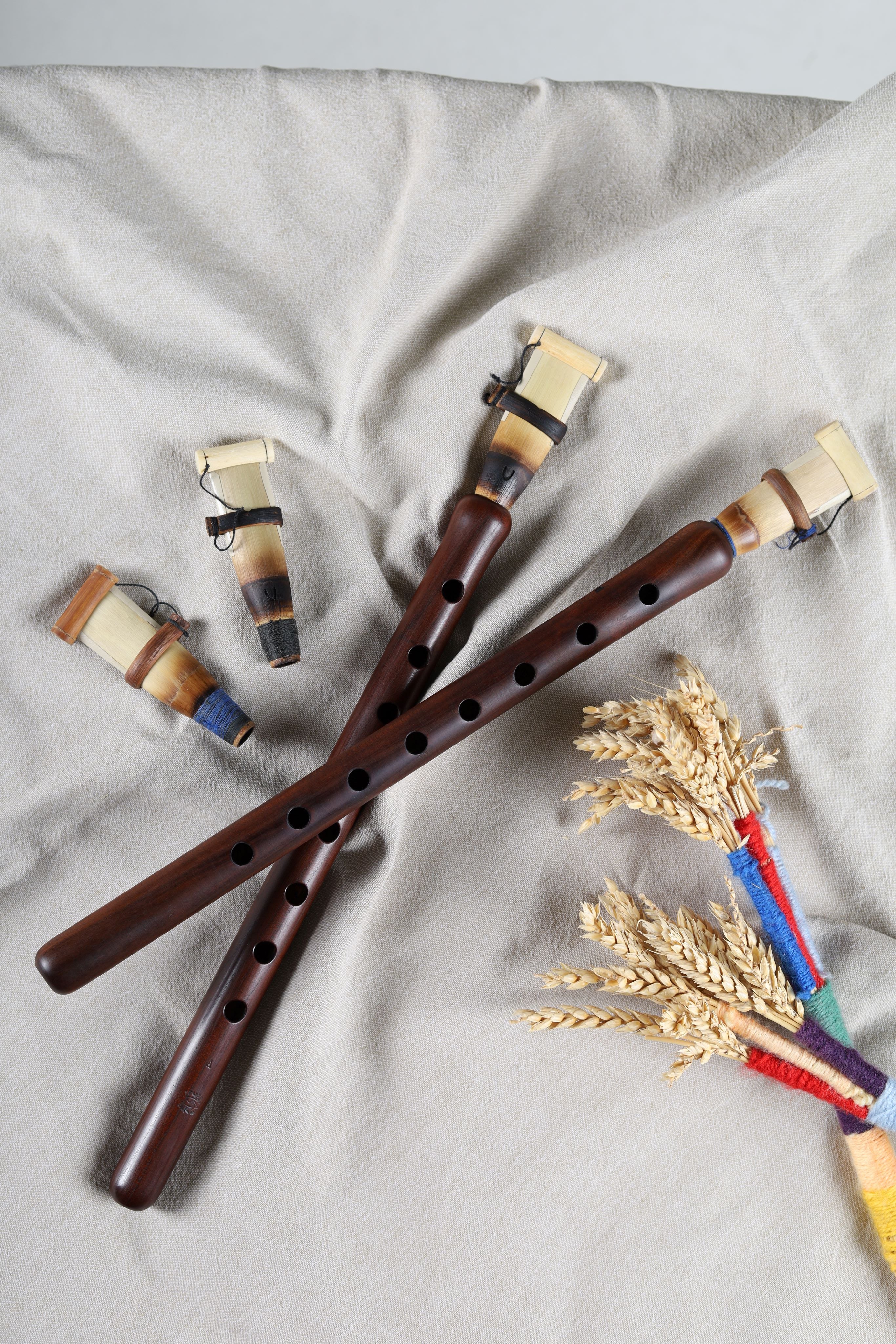Presentation
Arthur (Hovsepi) Grigoryan, born in 1976 in Yerevan, is one of Armenia’s foremost and most respected makers of traditional wind instruments, particularly the Duduk. A specialist in keyed models, an area in which he is now the most renowned and widely recognized authority, he markets his instruments under the brand name Arthur Grigoryan or AG. Heir to the craftsmanship of his father, the esteemed maker Hovsep Grigoryan (1928–2004), he continues to preserve and refine an artisanal tradition passed down through generations.

Arthur Grigoryan ©
Music in the Life of Arthur Grigoryan
Arthur Grigoryan grew up in an environment deeply immersed in music. His father, Hovsep Grigoryan, was not only a renowned Duduk maker but also an accomplished musician. Coming from a family of nine children, six of them boys, each played a different instrument : Duduk, Dhol, accordion or singing, together forming a unique ensemble in their own right.
During his father’s tours with fellow musicians, particularly in the villages surrounding Sepasar (Սեպասար), the family’s ancestral hometown, and in the city of Gyumri (formerly Leninakan), Arthur often accompanied them. These encounters, in close contact with musicians and local traditions, profoundly shaped his artistic sensibility.
Although he began learning the Duduk under Armen Grigoryan, Artur soon chose to focus on making the instrument rather than performing it. His passion for craftsmanship strengthened his determination to devote himself fully to its creation.

Hovsep Grigoryan performing in Sepasar (Սեպասար), 1990 ©
First Steps in Instrument Making
As the son of Hovsep Grigoryan, a musician and a highly respected maker of his time, Arthur Grigoryan seemed naturally destined to follow the same path. At the age of fifteen, he began taking an interest in his father’s work and, on his own initiative, trained alongside him in the craft of making wind instruments.
While his father opened the door to the world of craftsmanship, it was Arthur’s personal dedication that led him to forge his own success. Early on, he chose not to simply replicate the traditional Duduks made by his father but to explore an innovative approach: integrating key systems, inspired by the clarinet, oboe and other Western instruments, into the Armenian Duduk. Although he was not the first in Armenia to attempt this adaptation, makers such as Georgi Minasov, Abel and Ruzvelt had already experimented with it, Arthur distinguished himself by perfecting the key installation technique. His goal was clear: to understand musicians’ needs and create keyed Duduks that offered comfort, stability and precision, where existing models often lacked reliability and ergonomic design.
By developing this specialty, Arthur refined his expertise and quickly gained recognition. He received his first significant commissions from artists such as Djivan Gasparyan, who was impressed by the quality of his work after seeing an apricot wood clarinet entirely crafted by him. His instruments also attracted the attention of musicians in the United States, allowing him, in his early twenties, to launch a professional career devoted to Duduk making, with a particular focus on keyed models.
Today, after more than thirty years of activity, Arthur Grigoryan is regarded as one of the most experienced and active artisans in his field. His instruments, engraved with the name Arthur Grigoryan, have become a benchmark for both professional and amateur musicians, combining precision, stability and a distinctive tonal character.

One of the very first creations by Arthur Grigoryan ©
Crafting Philosophy
As an experienced maker, Arthur Grigoryan has developed over the years a personal approach to musical instrument making. He sums up his vision as follows: “In life, I always try to achieve perfection in each of my creations, whatever the field.”
For him, the musician’s comfort is essential, especially when performing technically demanding pieces. Having always evolved in an environment close to great masters of the Duduk, he has worked in close collaboration with them to improve his instruments according to their preferences. He believes that certain variations of the Duduk, such as the bass Duduk, still require further development to ensure smooth and ergonomic playability.
Recognized as one of the leading specialists in keyed Duduks, he is behind most of the models in circulation today and is a strong advocate of their value for musicians. The addition of one or more keys extends the range of an instrument whose tessitura has traditionally been limited, opening new possibilities for interpretation. He compares this evolution to that of the clarinet, which was once without keys and gradually perfected before developing into multiple variants (alto, bass, baritone, etc.).
Almost all of his instruments are made from apricot wood, the emblematic material of the Duduk. Although he has experimented with other fruitwoods (pear, apple, plum) as well as exotic woods such as ebony, cocobolo, and Brazilian kingwood, he always returns to apricot for its acoustic qualities and its availability in Armenia. However, he notes that the choice of wood remains a matter of taste: while some prefer the warm resonance of apricot, others appreciate the precision and neutrality of ebony, which in his view offers a different projection.
In each of his creations, Arthur seeks a balance between sound quality, accuracy, aesthetics, and playing comfort. He emphasizes the importance of maintaining a good balance between ease of play and tonal richness, without sacrificing one for the other. Attentive to musicians, he does not hesitate to adapt the tuning of his instruments to match their style or specific needs. This constant demand for quality, combined with attentive listening and great flexibility, explains why many professional musicians place their trust in his instruments.
Inventions and Improvements by Arthur Grigoryan
With more than thirty years of experience and as the heir to the know-how passed down from his father, Arthur Grigoryan has not only perfected the art of Duduk making but has also introduced technical improvements in response to the specific needs of musicians, particularly those performing on stage.
Improvement – Keyed Duduk
Although not its inventor, Arthur Grigoryan has established himself as a master of the keyed Duduk, a design inspired by the mechanisms of Albert and Boehm clarinets. While similar models already existed in Armenia, they were often unreliable, uncomfortable to play, and of inconsistent quality. Arthur therefore refined their design, working on precision, playing comfort, and tonal stability, until he produced an instrument that is both reliable and capable of meeting the demands of professional musicians.
The making of a keyed Duduk is rare and complex, requiring mastery of several skills: the work of a goldsmith for the creation or adaptation of the keys, the shaping of the wooden body, followed by the assembly and tuning carried out by Arthur himself. Today, this instrument is produced almost exclusively to order and, over time, has become Arthur Grigoryan’s signature specialty.
Musicians Using Arthur Grigoryan’s Instruments
With this long-standing experience, Arthur Grigoryan has established himself as one of the most respected and active craftsmen in the making of Duduks and other traditional Armenian wind instruments. His expertise, particularly in the installation of key systems, has attracted many renowned musicians, including Emmanuel Hovhannisyan, Norayr Gapoyan, Vardan Grigoryan, Vahan Harutunyan, Rostom Khachikian, and many others.
Throughout his career, he also earned the trust and respect of Djivan Gasparyan who, during his lifetime, was first closely connected to Hovsep Grigoryan before forming a special relationship with Arthur, thus preserving an artistic and human bond between the two generations.
Today, the majority of professional musicians who play keyed Duduks turn to his creations. They rely on them both for live performances and for studio recordings, valuing the reliability, comfort, and tonal quality of his instruments.

Arthur Grigoryan and Djivan Gasparyan ©
Official Recognition and Status
Status
Arthur Grigoryan remains, above all, an independent craftsman, faithful to a deeply personal approach to his work. He personally oversees every stage of design and production, from the selection of the wood to the final finishing touches.
Unlike mass-production workshops, where each task is standardized and assigned to different workers, he insists on maintaining full control over every creation. Inherited from the philosophy passed down by his father, this direct involvement gives each of his instruments a living, unique, and authentic character.
Transmission
To date, Arthur Grigoryan has not trained an apprentice and has not yet considered passing on his know-how directly to his children, due to their young age. This craft, deeply rooted in the family’s history and tradition, requires commitment, trust, and an intimate understanding of the making process, which he feels is difficult to instill in those outside the family. For now, he prefers to devote himself fully to his work and the pursuit of his own projects.
Meet Arthur Grigoryan
Arthur Grigoryan works primarily in the historic workshop founded in 1989 by his father, located at 29 Khorenatsi Street, 1st district, in Yerevan. This space of about 30 m², rich in history, has hosted many memorable musical encounters. Open to the public, the workshop is for him a privileged place of exchange, where he always welcomes music and instrument-making enthusiasts with great pleasure.

Hovsep Grigoryan welcoming Djivan Gasparyan at 29 Khorenatsi Street, 1st district ©
Sources
The information presented in this blog article is based on direct exchanges with Arthur Grigoryan. To ensure the accuracy of the content, the article has been reviewed and approved by Arthur Grigoryan himself, with the aim of providing you with the most precise details regarding his biography and career.

